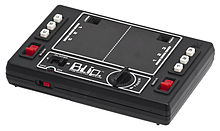
Table tennis, also known as ping-pong and whiff-whaff, is a racket sport derived from tennis but distinguished by its playing surface being atop a stationary table, rather than the court on which players stand. Either individually or in teams of two, players take alternating turns returning a light, hollow ball over the table's net onto the opposing half of the court using small rackets until they fail to do so, which results in a point for the opponent. Play is fast, requiring quick reaction and constant attention, and is characterized by an emphasis on spin relative to other ball sports, which can heavily affect the ball's trajectory.

The Magnavox Odyssey is the first commercial home video game console. The hardware was designed by a small team led by Ralph H. Baer at Sanders Associates, while Magnavox completed development and released it in the United States in September 1972 and overseas the following year. The Odyssey consists of a white, black, and brown box that connects to a television set, and two rectangular controllers attached by wires. It is capable of displaying three square dots and one line of varying height on the screen in monochrome black and white, with differing behavior for the dots depending on the game played. Players place plastic overlays on the screen to display additional visual elements for each game, and one or two players for each game control their dots with the knobs and buttons on the controller by the rules given for the game. The console cannot generate audio or track scores. The Odyssey console came packaged with dice, paper money, and other board game paraphernalia to accompany the games, while a peripheral controller—the first video game light gun—was sold separately.

A game controller, gaming controller, or simply controller, is an input device or input/output device used with video games or entertainment systems to provide input to a video game. Input devices that have been classified as game controllers include keyboards, mouses, gamepads, and joysticks, as well as special purpose devices, such as steering wheels for driving games and light guns for shooting games. Controllers designs have evolved to include directional pads, multiple buttons, analog sticks, joysticks, motion detection, touch screens and a plethora of other features.

The Nokia 6230 is a mobile phone based on the Nokia Series 40 platform. It was announced on 28 October 2003 and released in February 2004.
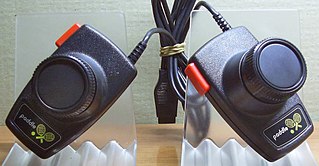
A paddle is a game controller with a round wheel and one or more fire buttons, where the wheel is typically used to control movement of the player object along one axis of the video screen. A paddle controller rotates through a fixed arc ; it has a stop at each end.
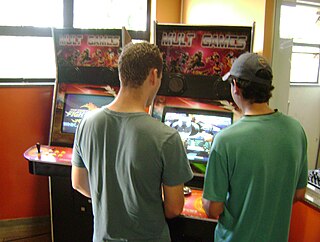
An arcade cabinet, also known as an arcade machine or a coin-op cabinet or coin-op machine, is the housing within which an arcade game's electronic hardware resides. Most cabinets designed since the mid-1980s conform to the Japanese Amusement Machine Manufacturers Association (JAMMA) wiring standard. Some include additional connectors for features not included in the standard.

The Nokia 3310 is a discontinued GSM mobile phone announced on 1 September 2000, and released in the fourth quarter of the year, replacing the popular Nokia 3210. It sold very well, being one of the most successful phones, with 126 million units sold worldwide, and being one of Nokia's most iconic devices. The phone is still widely acclaimed and has gained a cult status due to its reputation for durability.

Screwball Scramble is a toy made by Tomy that involves guiding a 14-millimeter-diameter chrome steel ball bearing around an obstacle course. A player guides the ball by using various buttons, dials and levers that affect parts of the course. If a mistake is made a player must start again. The aim of the game is to complete the course as fast as possible. It takes no batteries and is recommended for children five and above. The toy was popular during the 1980s, and is still available today.
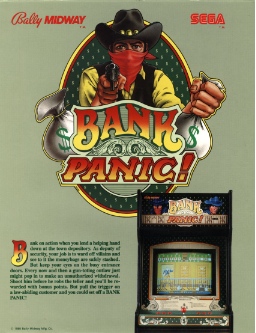
Bank Panic is an arcade shooter game developed by Sanritsu Denki and released by Sega in 1984. Bally-Midway manufactured the game in the US. The player assumes the part of an Old West sheriff who must protect a bank and its customers from masked robbers.

The APF TV Fun brand is a series of dedicated home video game consoles manufactured by APF Electronics Inc. and built in Japan starting in 1976. The systems were among the first built on the General Instrument "Pong-on-a-chip", the AY-3-8500, that allowed many manufacturers to compete against the Atari Home Pong. The APF TV Fun consoles were one of the earliest pong clone consoles.
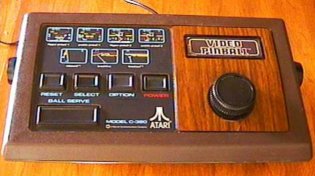
The Video Pinball brand is a series of first-generation single-player dedicated home video game consoles manufactured, released and marketed by Atari, Inc. starting in 1977. Bumper controllers on the sides or a dial on the front are used to control the games depending on the game selected. There are three game types in the first model of the Video Pinball series: Pinball, Basketball, and Breakout.
The TV Scoreboard is a Pong-like dedicated home video game console manufactured in Hong Kong from 1976 through the early '80s and made by Tandy. Distribution was handled exclusively by RadioShack.
The Omnibot (オムニボット) is a toy robot originally manufactured by Tomy in the mid-1980s. The name then came to apply to the successful line of robots manufactured by the company. The initial Omnibot was announced with expectations of restoring popular interest in robots, at a time when it was becoming obvious that robots with advanced AI such as R2-D2 were still a long way away. A more advanced version of the Omnibot was called the Omnibot 2000 and did not have a plastic bubble over its head. With the success of the Omnibots, the Omnibot range quickly expanded. After the video game crash of 1983 and its debilitating effect on the nascent home electronics industry, the Omnibot faded away but it was revived in the early 2000s. The latest version of the Omnibot is the i-SOBOT.

The R-Zone is a portable game console developed and manufactured by Tiger Electronics. The R-Zone was shown at the American International Toy Fair in February 1995, and was released later that year. The R-Zone was panned by critics, and was also a commercial disaster, with its lifespan lasting only 2 years before being discontinued in 1997. Although the R-Zone was not designed to compete directly with any other handhelds, it marked Tiger Electronics' first multi-game entry into the portable electronic game market.

The Atari Video Music is the earliest commercial electronic music visualizer released. It was manufactured by Atari, Inc., and released in 1977 for $169.95. The system creates an animated visual display that responds to musical input from a Hi-Fi stereo system for the visual entertainment of consumers.
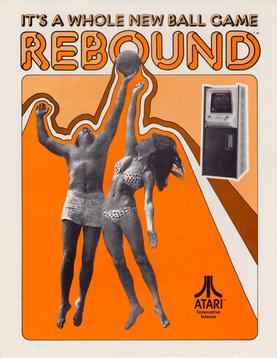
Rebound is a two-player sports arcade video game developed by Atari] and released in February 1974. In the game, two players each control paddles on either side of a volleyball net, with a ball dropped from the top of the screen. The players bounce the ball back and forth across the net with the goal of scoring points by having the ball reach the bottom or side of the other player's half of the screen, with the trajectory of the ball dependent on where it strikes the paddle. The winner is the first player to reach eleven or fifteen points, depending on the game settings.
Magnavox Odyssey is the general brand name of Magnavox's complete line of home video game consoles released from 1972 through 1978. The line includes the original Magnavox Odyssey console, the Magnavox Odyssey series of dedicated home video game consoles, and the Magnavox Odyssey 2 ROM cartridge-based video game console released in 1978. Philips Odyssey is the brand name that includes the Philips Odyssey series of dedicated home video game consoles.

The Game & Watch brand is a series of handheld electronic games developed, manufactured, released, and marketed by Nintendo from 1980 to 1991. Created by game designer Gunpei Yokoi, the product derived its name from it featuring a single game as well as a clock on an LCD screen. The models from 1981 onwards featured an alarm in addition.
Triple Hunt is a shooter-style arcade game developed by Atari and released in April 1977. Triple Hunt's main feature is its mounted light gun, which is used to shoot at the screen on a separate cabinet. Each Triple Hunt unit houses three changeable games; Witch Hunt, Hit The Bear, and Raccoon Hunt. The game graphics are displayed over the background graphics, and when a monitor mask is placed on the screen, the graphics 'disappear' behind the mask. Since the gun is light operated, the shots would not go through the mask, and did not count. It was first introduced at the Third Annual Distributor Meeting banquet on March 22, 1977.
